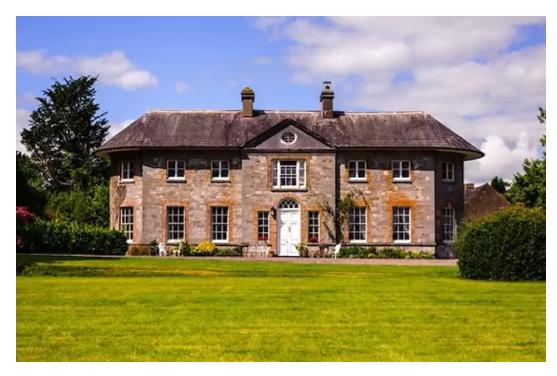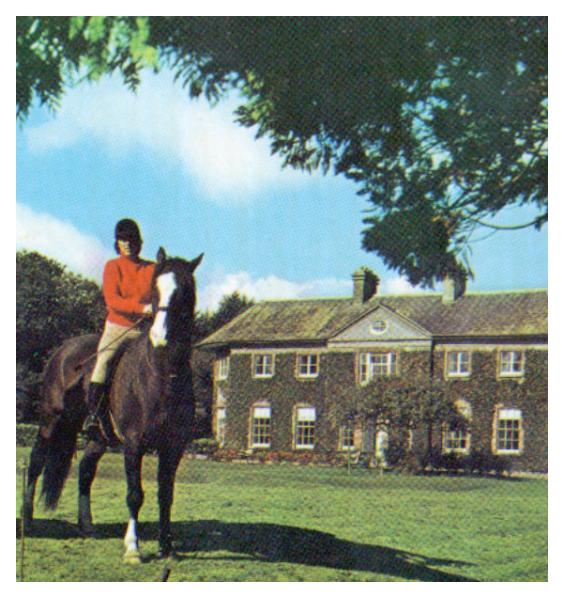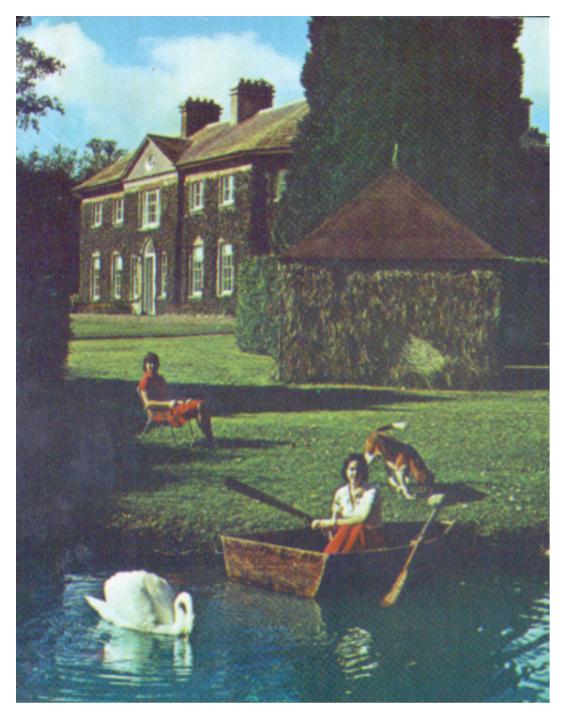Assolas House is the oldest known and perhaps the most historic residence in Duhallow. It was the focal point in the Battle of Knocknanuss in November 1647. Prior to the reformation (1558), it is generally accepted that Assolas was occupied by a community of Catholic monks.
The present stone out-offices with the still visible castings of closed-up windows, all in an excellent state of preservation, bear ample testimony to its monastic nature. A unique feature of this building is the presence of a “Leper’s Peep”, still visible, and which lends much weight to the theory of its religious origins. It notable that the “Leper’s Peep” has been a source of much interest and controversy to historians during the past century.
 The original house is today the centre of the present residence. The shape of the windows, the exterior of rough stone and mortar, strengthened by the addition of horse hair and ox blood, the great thickness of the walls, and the wood-panelled first floor rooms, are all in keeping with these monastic origins. The east wing would appear to have been added about a hundred years after the original building. Perhaps its most interesting features are the beautifully rounded frontage, the deep cantilever roof with windows just below, and the large old flagstone kitchen on the ground floor (the White dining room – which incidentally was in use up to 1915).
The original house is today the centre of the present residence. The shape of the windows, the exterior of rough stone and mortar, strengthened by the addition of horse hair and ox blood, the great thickness of the walls, and the wood-panelled first floor rooms, are all in keeping with these monastic origins. The east wing would appear to have been added about a hundred years after the original building. Perhaps its most interesting features are the beautifully rounded frontage, the deep cantilever roof with windows just below, and the large old flagstone kitchen on the ground floor (the White dining room – which incidentally was in use up to 1915).
Unfortunately, no records are available to tell us when precisely the front wing was built. One can only surmise that it was in the latter half of the 18th century. It is most certainly Queen Ann style with the added rounded gables giving a soft exterior and a beautifully proportioned interior. The windows, all the woodwork, in particular the fresco around the hall ceiling, and the carved doors are the work of skilled craftsmen, while most of the window panes throughout the house are the original hand blown glass with all its imperfections. For nearly seventy years after the Battle of Knocknanuss, the shrouded mists of time have veiled the secrets of Assolas in its four and a half foot thick walls until 1714 when Reverend Francis Gore took up residence. He was responsible for much of the present layout of the house and gardens. The residence and surrounds prospered under his management.
 Reverend Gore seems to have been a man of means and influence. He was also a minister and a Protestant Rector of Castlemagner parish for 34 years. He died on May 10 1748 and is buried under the reading desk in the Church of Ireland Church, Castlemagner. During his life at Assolas, the road from Kanturk to Cecilstown had not been constructed. An old carriage way ran through Lisduggan and crossed the river at a ford, still visible today beside Assolas House, joining the present road at Lacken Leigh. Every night during his 34 years at Assolas, Reverend Gore hung a lantern high on the wall of the house shining its light on the waters of the ford to guide the travelers on their way. It is reported that, during this period, highwaymen often lurked at dangerous crossings for innocent victims. Assolas House was always open to receive the wounded should they fall prey to roaming bands. This warm friendly light became so well known that the house by the ford took its name in Gaelic, the spoken language of the time, as Atha Solas (the ford of the light, later adapted to its English version, Assolas). As a final tribute to Reverend Gore, the ruling Church of Ireland authorities granted the use of a private pew in Castlemagner Church of Ireland Church to the owner of Assolas.
Reverend Gore seems to have been a man of means and influence. He was also a minister and a Protestant Rector of Castlemagner parish for 34 years. He died on May 10 1748 and is buried under the reading desk in the Church of Ireland Church, Castlemagner. During his life at Assolas, the road from Kanturk to Cecilstown had not been constructed. An old carriage way ran through Lisduggan and crossed the river at a ford, still visible today beside Assolas House, joining the present road at Lacken Leigh. Every night during his 34 years at Assolas, Reverend Gore hung a lantern high on the wall of the house shining its light on the waters of the ford to guide the travelers on their way. It is reported that, during this period, highwaymen often lurked at dangerous crossings for innocent victims. Assolas House was always open to receive the wounded should they fall prey to roaming bands. This warm friendly light became so well known that the house by the ford took its name in Gaelic, the spoken language of the time, as Atha Solas (the ford of the light, later adapted to its English version, Assolas). As a final tribute to Reverend Gore, the ruling Church of Ireland authorities granted the use of a private pew in Castlemagner Church of Ireland Church to the owner of Assolas.
The pages of history turn Assolas:
In 1749 Assolas passed from Mr Gore to Mr Phillip Oliver, J.P. for County Cork. Subsequent transfers were as follows:
Henry Wrixon, Sir William Beecher Bart 1794
William Harris J.P. 1814
William Beecher D.L. 1830 Hayden O’Brien 1850
Henry Smith Iron Founder, Cork 1880
Colonel O’Hare 1900
Sir John Beecher Bart 1902
Hon Alexis Roche 1904
Burke family (1915)
The Burkes are the first Catholic owners of Assolas since the far off days of the monks some 300 years earlier.
To the present day, Assolas has withstood the ravages of time, seen war, strife, prosperity, and famine. The grounds still have many ancient yew trees that were planted exclusively in the early days for a plentiful supply of good quality bows. What the future holds for Assolas no one knows but it will continue to stand as a silent monument to the skills and craftsmanship of the unknown people who built it many centuries ago.
Historical Note:
Sir William Beecher of Assolas House was the first master of the Duhallow Hounds. The hounds were kennelled at Assolas.

Honourable Alexis Roche, the last Beecher tenant before the present owners, died 18 December 1914 and is buried in a small grave in Castlemagner cemetery. He was a great uncle of the deceased Princess of Wales, Lady Diana Spencer. Mr Roche’s great granddaughter is married to Patrick Mayhew, the former Tory Secretary of State for Northern Ireland. He was a recognised judge of horses and built 12 stables at Assolas. He derived a considerable portion of his income from the sale of horses.
GUESTHOUSE DETAILS (no longer in business)
Assolas Country House
Grade A (Reg. I T. B.)
Tel: +353 (29) 50015
Fax: +353 (29) 50795
Over the past 30 years Assolas Country House & Restaurant has earned itself an enviable international reputation for its food, grounds, and hospitality. Assolas House has been featured in many American, British and Irish Television programmes and also many international magazines and newspapers including:
Gourmet & Bon Appetite
Home & Gardens
The Times
The Telegraph
The Mail on Sunday
Gault Milieu (France)
Country Living (American)
Country Living (British)
Assolas House has received many awards including:
Two Red Symbols
The Michelin Guide
Caesar Award
Good Hotel Guide (1995) judging Assolas the best small hotel in Ireland
Egon Ronay Star
Two Galtee Breakfast Awards
AA Rosette for high standard of food served
Irish Cheese of the year (1995)
Egon Ronay Regional Meat Restaurant of the year (1994)
Egon Ronay Gilby’s Gold Medal Award for excellence in Catering (1994)
Bridgestone Guide Star (1995)
Assolas has also received the 5 Qs top award from the AA as a premium quality Guesthouse (1993) (1994) and (1995). It has been selected their top choice in Ireland. The Grounds & Gardens of Assolas have also received high praise and many awards including the All Ireland National Bord Failte Garden Award. This is reflected also in the two awards received from Bord Failte Environmental Development Department.


On reading the story of Assolas,the names of previous owners Henry Wrixon and Sir William Beecher Bart (1794) jumped off the screen. These were the gents named by convict Denis Higgins (1787 – 1847) as referees in his 1835 Petition to the Governor, Major General Richard Bourke to have his family brought out from Ireland to the Australian colony “at the Expense of the Government”.
From this evidence, it may be assumed (??) that Denis worked for these gents from whom he allegedly filched the odd sheep !
Another piece of the jigsaw falls neatly into place.
Thanks to Ed O’Donoghue.
Thanks Ed for publishing this research! My great-great uncle has diary entries of visits made to an “Owen Bourke” at “Assolas” while he was on leave from the AIF during WW1. Until I saw the Bourke family had purchased the property in 1915 I couldn’t piece the puzzle together. Thank you!
(The Bourke family – Matthew Bourke (father) was Recorder of Cork – also owned Lodge Banteer nearby. That property later became Dunhallow Park Hotel until demolished about four or five years ago)